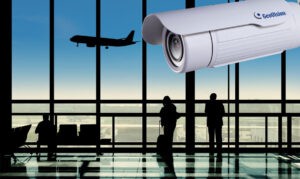
If you’re wondering who stands to benefit most from the exciting advancements being made in video surveillance technology in recent years, look no further than the nearest major airport.
Airports have a lot to deal with when it comes to security. From facing the ever-present threat of terrorism, to enforcing strict rules and regulations, airport security personnel operate in a fast-paced environment that offers no room for mistakes. IP surveillance technology and new innovations in video analytics are helping to raise airport security to new heights.
Benefits of IP-Based Video Surveillance for Airport Terminals
Combat terrorism – It’s an unfortunate fact that airports are targets for terrorist activity. For that reason, it’s vitally important that airports employ extremely strict security measures. Video surveillance systems play a key role in protecting against acts of terrorism. The proper system will provide authorities with invaluable tools in their efforts to maintain the highest possible levels of security.
Provide real-time surveillance to multiple departments – With IP surveillance enabling digital surveillance streams to travel over the internet, operators in various airport departments such as police, customs, fire and medic, baggage, and airport operations, can all monitor the video feeds from separate PC workstations.
Advanced video analytics – Intelligent IP cameras with built-in video analytics are beginning to play a significant role in airport security. These IP cameras utilize software algorithms to detect specific activities and scan for suspicious individuals. For instance, IP cameras with facial recognition technology work to help authorities find terrorist threats and marked individuals on government watch lists. Using behavioral recognition technology, IP cameras can be programmed to detect incidents such as left objects, congestion, reverse movement through checkpoints, and cars spending too much time parked in one spot outside of the building. With these features running through IP cameras themselves, the analytics operate in real-time.
Flexibility and scalability – IP video surveillance systems are scalable, meaning they can grow as needed, or as the airport grows. Additional IP cameras are easily connected to the network, and pre-existing analog IP cameras can even be incorporated into new systems by using digital encoders.
Digital storage – With IP surveillance, video footage is recorded and stored digitally, unlike analog systems which archive footage on clunky cassette tapes. This allows for an almost unlimited amount of storage, and also provides users with drastically enhanced search capabilities.
Remote access – IP-based surveillance systems send live video streams over the internet, where they can be viewed, along with archived footage, remotely from any PC with network access. This allows authorized users to monitor airport activities from off-site locations.

Risks of Airport Surveillance Systems
Over reliance – An advanced video surveillance network is only one part of a larger effort when it comes to airport security. New technology can go a long way in aiding this cause, but it shouldn’t come at the expense of other safety measures such as proper security personnel staffing.
Configuration of Video Surveillance Systems for Airports
Airports feature a number of diverse areas that all demand extremely high levels of security. The following factors should be considered when exploring the installation of an airport surveillance system:
- What is the airport’s history in terms of reported crimes and disturbances?
- What security systems are currently in place throughout the airport?
- What type of security personnel patrol the facility?
- Have terrorist plots been attempted or carried out through the airport?
- Does the airport consist of separate sections linked by a tram or other modes of transportation?
- Does the airport get extremely busy and chaotic at certain points throughout the day?
- Are security checkpoints properly staffed and thorough in their procedures?
- Are there sections of the facility that are considered high-risk areas requiring special attention?
- What systems are in place to prevent outsiders from gaining access to restricted areas?
- How is employee identification and access control handled?
- What security measures are in place to protect planes and equipment?
Security IP Camera Setup Advice for Airport Terminals
- Position IP cameras at all entrances and exits in order to capture footage of everyone who passes through the airport
- Monitor all open areas to get continuous overall footage of airport activity.
- Situate IP cameras around airline check-in areas to obtain images of passenger arrivals and procedures.
- Monitor security checkpoints for congestion, suspicious activity, confrontations, and passengers who present potential threats.
- Install surveillance for trams or other modes of transportation used to connect one part of the airport to another.
- Monitor individual terminals and gates for unusual activity in the boarding process and suspicious passengers.
- Install IP cameras in baggage claim areas to prevent theft and to watch for potentially dangerous items.
- Monitor corridors and all areas used for traveling throughout terminals.
- Install IP cameras that provide views of restricted areas to ensure that only authorized personnel gain access.
Source: Video Surveillance



































































